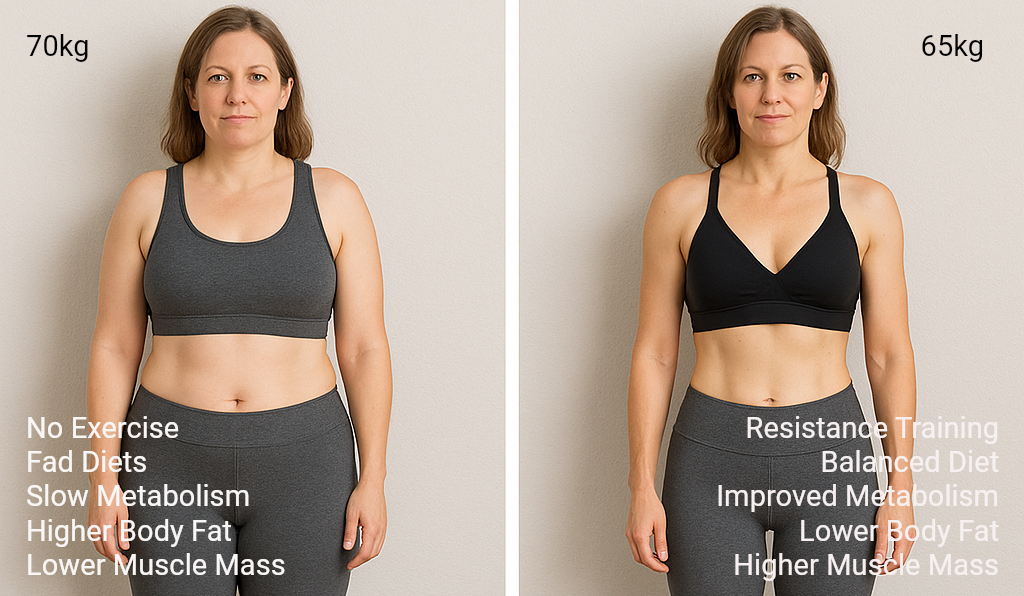The Hidden Cost of "Dieting Only": Why Skipping Exercise Can Sabotage Your Weight Loss
When we embark on a weight loss journey, our immediate focus often turns to calorie restriction.
"Eat less, lose weight!" seems like a simple mantra.

And while a calorie deficit is fundamental to weight loss, relying solely on cutting calories without incorporating physical activity, especially resistance training, can lead to a deceptive form of weight loss that ultimately sabotages your long-term success.
Let's break down how your body prioritizes its fuel sources and why activity is so crucial.
And while a calorie deficit is fundamental to weight loss, relying solely on cutting calories without incorporating physical activity, especially resistance training, can lead to a deceptive form of weight loss that ultimately sabotages your long-term success.
Let's break down how your body prioritizes its fuel sources and why activity is so crucial.
Your Body's Fuel Hierarchy During Calorie Restriction
Imagine your body as a sophisticated organism constantly seeking energy to power every function, from thinking to breathing to moving. When you restrict calories, it goes searching for available fuel. Here's the order of preference:
- Glucose & Glycogen (Carbohydrates): The "Quick Cash"
- Your body's absolute favourite and most readily available fuel is glucose, derived from carbohydrates. It circulates in your blood and is stored as glycogen in your liver and muscles. During a calorie deficit, these stores are the first to be depleted. Once they're low, your body moves on to other sources.
- Adipose Tissue (Stored Fat): The "Emergency Savings Account"
- This is what we want to tap into for weight loss! Your body stores a vast amount of energy as fat. Ideally, once glucose and glycogen are low, your body would seamlessly transition to burning this stored fat.
- Protein (from Muscle Tissue): The "Last Resort" (but easily accessed without the right signals)
- This is where things get tricky. Your body can break down protein, primarily from your muscle tissue, into amino acids. These amino acids can then be converted into glucose (a process called gluconeogenesis) to fuel essential functions, especially those of the brain, which prefers glucose.
The Trap: Dieting Without Movement
Here's the critical point: If you're on a low-calorie diet but are largely inactive, your body can become "reluctant" to burn stored fat effectively, and worse, it's more likely to break down precious muscle tissue for energy.
Why does this happen?
- No Demand Signal: Muscle is metabolically "expensive." It requires a lot of energy to build and maintain, even at rest. If you're not using your muscles through activity, your body doesn't receive the strong signal that they are vital. In an energy-scarce environment (your calorie-restricted diet), your body may perceive muscle as a luxury it can't afford and starts to dismantle it to save energy and provide glucose.
- Prioritizing Glucose for Essential Functions: Without sufficient carbohydrates from your diet, and without the energy expenditure from exercise demanding fat as fuel, your body will turn to the next readily available source for gluconeogenesis – your muscle protein.
- Reduced Overall Energy Burn: A sedentary lifestyle means your body simply isn't burning many calories throughout the day. While you're creating a deficit through diet, the total energy turnover is low, making the process of tapping into fat stores less efficient.
So, if you're on a low-calorie diet only and are not active, you might not burn fat effectively because your body is reluctant to use stored fat. Instead, it might prioritize breaking down muscle tissue for energy and to provide necessary glucose.
The Solution: Activity (Especially Resistance Training) as a Muscle Preserver and Fat Burner
Now, let's contrast this with what happens when you incorporate physical activity:
- Demand Creates Preservation: When you engage in resistance/strength training (lifting weights, bodyweight exercises, resistance bands), you send a powerful signal to your body: "These muscles are being used! They are essential! Do not break them down!" This stimulus is a potent trigger for muscle-preserving mechanisms, even in a calorie deficit.
- Fueling Activity with Fat: When you're active, your body needs more energy. Once immediate glucose and glycogen stores are depleted during longer or more intense activities, your body is much more likely to tap into your "emergency savings account"—your stored fat—to fuel those daily and purposeful activities.
- Increased Overall Calorie Burn: Any form of activity increases your total daily energy expenditure, creating a larger calorie deficit. This forces your body to rely more heavily on its stored energy reserves, making fat loss more efficient.
The Long-Term Impact: Why Muscle Mass is Your Metabolic Gold
Preserving muscle mass isn't just about looking toned; it has profound, positive impacts on your long-term weight loss and metabolic health:
- Metabolic Powerhouse: Muscle tissue is significantly more metabolically active than fat tissue. This means that even at rest, your muscles burn more calories. The more muscle you have, the higher your Resting Metabolic Rate (RMR).
- Imagine: Losing 10 pounds (4.5kg) of muscle means your body burns hundreds fewer calories each day just to exist, making it much harder to maintain weight loss. Losing 10 pounds of fat while preserving muscle means your metabolism stays robust.
- Sustainable Weight Loss: When you lose muscle, your RMR drops. This means that to maintain your new, lower weight, you have to eat even fewer calories than before, making adherence incredibly difficult. This is a major reason for the notorious "yo-yo" effect. Preserving muscle helps keep your metabolism humming, making it easier to maintain your goal weight without extreme deprivation.
- Improved Body Composition: Even if the number on the scale doesn't drop dramatically, you'll look and feel much better with more muscle and less fat. You'll be stronger, have more energy, and your clothes will fit differently.
- Better Health Markers: Maintaining muscle mass is linked to better insulin sensitivity, improved bone density, and a lower risk of chronic diseases.
Conclusion: Exercise isn't Just for Burning Calories – It's for Preserving Your Metabolism
Simply cutting calories might lead to initial weight loss, but if that weight loss comes at the expense of muscle, you're setting yourself up for a slower metabolism, increased difficulty in maintaining weight, and a less healthy body composition overall.
For truly sustainable, healthy weight loss, prioritize both a moderate calorie deficit AND consistent physical activity, with a strong emphasis on resistance training. Fuel your body with adequate protein, challenge your muscles, and let your body efficiently burn fat while preserving its metabolic engine. That's the real secret to long-term success.

